Don’t miss…
Don’t miss…
Visit André Le Nôtre's masterpieces. On Fountain Show and Musical Gardens days, you can visit certain groves that are usually closed.
North Parterre
The North Parterre, situated in front of the King's Grand Apartment, is surrounded by eighteen sculptures, of which fifteen date back to the great commission of 1674. The iconography evokes the myth of Apollo and his nurturing and influential journey around the globe.
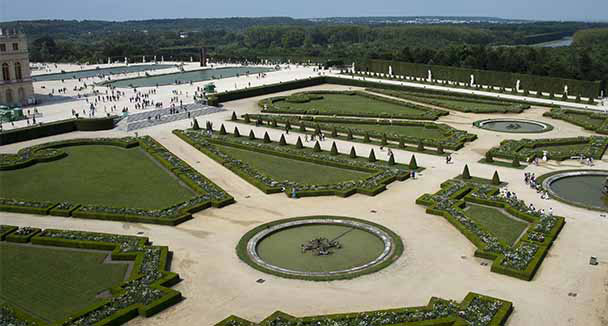
Water Garden
The Water Garden appears to be an extension of the facade of the Palace. Their layout was modified several times before receiving its definitive form, in 1685. Each pool is decorated with statues of lying-down figures representing the rivers of France, accompanied by nymphs and children.
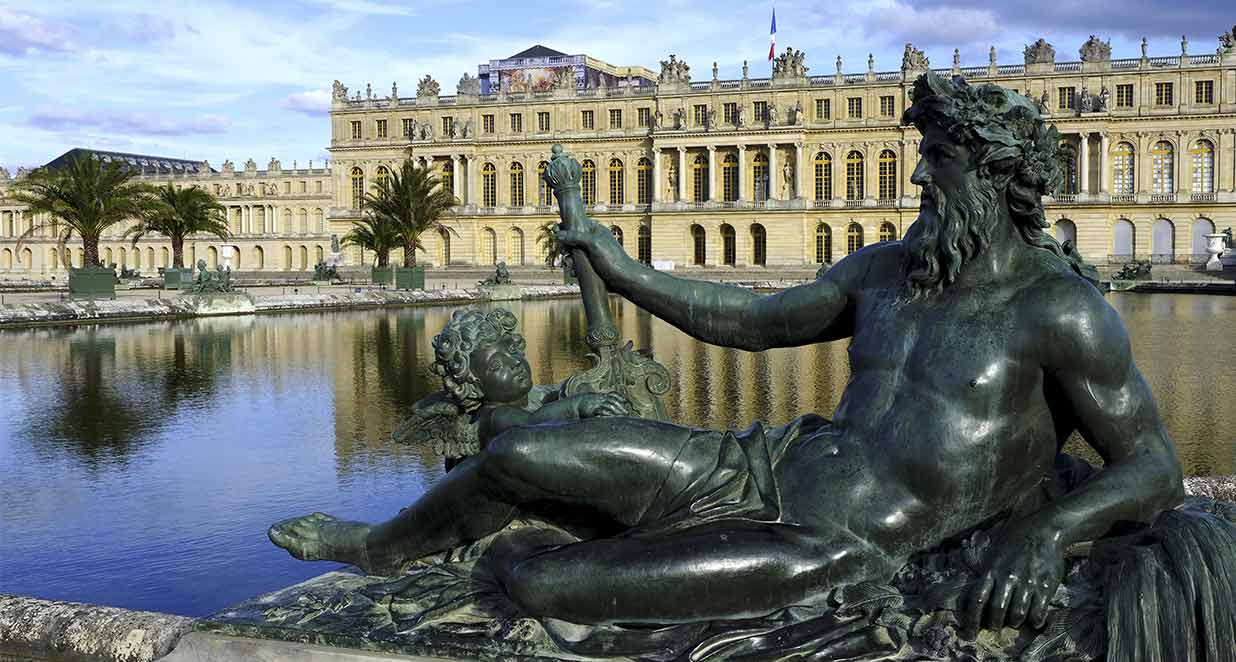
South Garden
Formerly known as the Flowers Parterre, the South Garden is situated above the Orangerie. During the reign of Louis XIV, brightly-coloured flowers were continually planted and replanted here: wallflowers, hyacinths, jasmine, tulips...
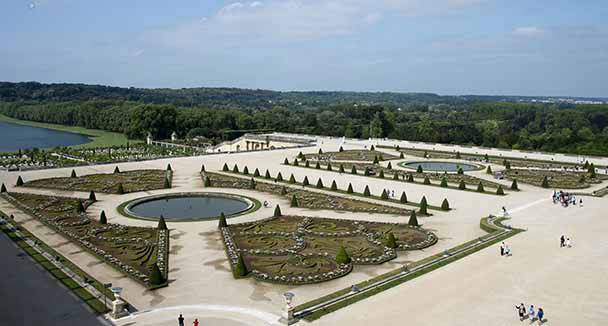
The Orangery Garden
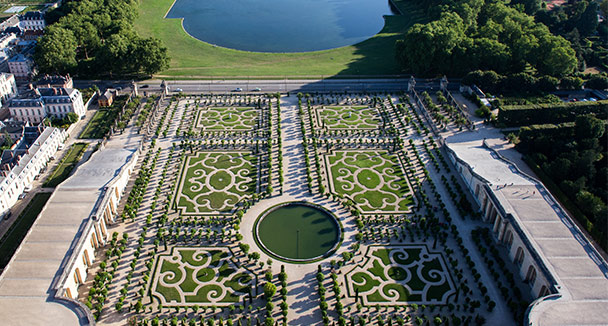
Dragon Fountain
The Dragon Fountain represents an episode from Apollonian legend: The young Apollo kills the serpent Python with an arrow. The reptile is surrounded by dolphins and Cupids with bows and arrows, riding on swans. The main fountain reaches twenty seven metres in height.

Latona's Fountain
This group of sculpted marble figures of Latona and her children is one of the most famous works of Versailles, made in 1670 by the Marsy brothers and lending its name to the fountain on which it proudly stands. Inspired by Ovid’s Metamorphoses, Latona's Fountain illustrates the transformation of the Lycian peasants into amphibians after they prevented the goddess and her children, Diana and Apollo, from quenching their thirst. The pool and parterre surrounding the fountain, designed by André Le Nôtre, were fully restored in 2015.
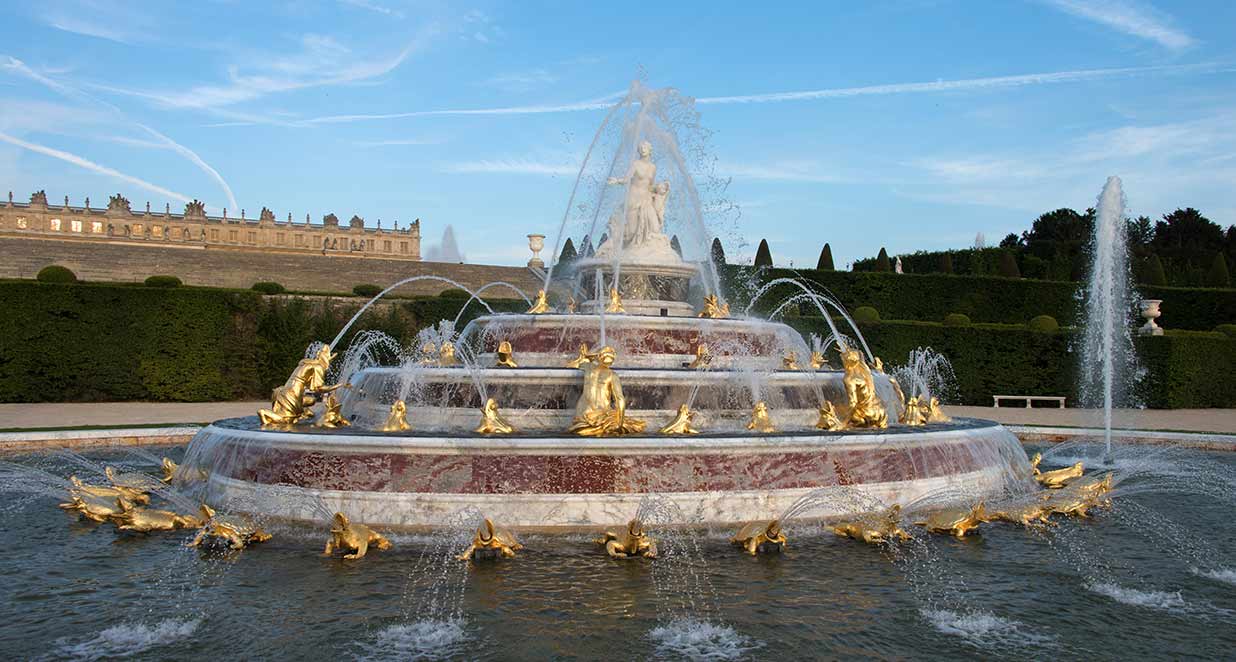
Apollo’s Baths Grove
The current grove dates from the reign of Louis XVI and was built between 1778 and 1781. The central pool is overlooked by a large artificial rock decorated with waterfalls and hollow caves. It houses the sculpted groups of The Horses of the Sun standing either side of Apollo Served by Nymphs, by François Girardon and Thomas Regnaudin.
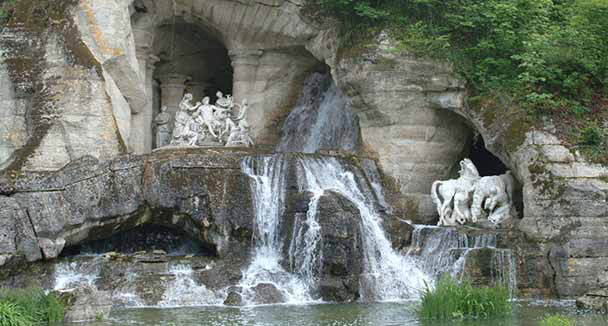
The Girandole Grove
The Girandole Grove, which forms a pair with the Dauphin Grove, has seen few modifications since its creation. It is decorated with terms commissioned by Nicolas Fouquet, once Superintendent of Finances to Louis XIV, for the Château of Vaux-le-Vicomte and made in Rome after models by Poussin.
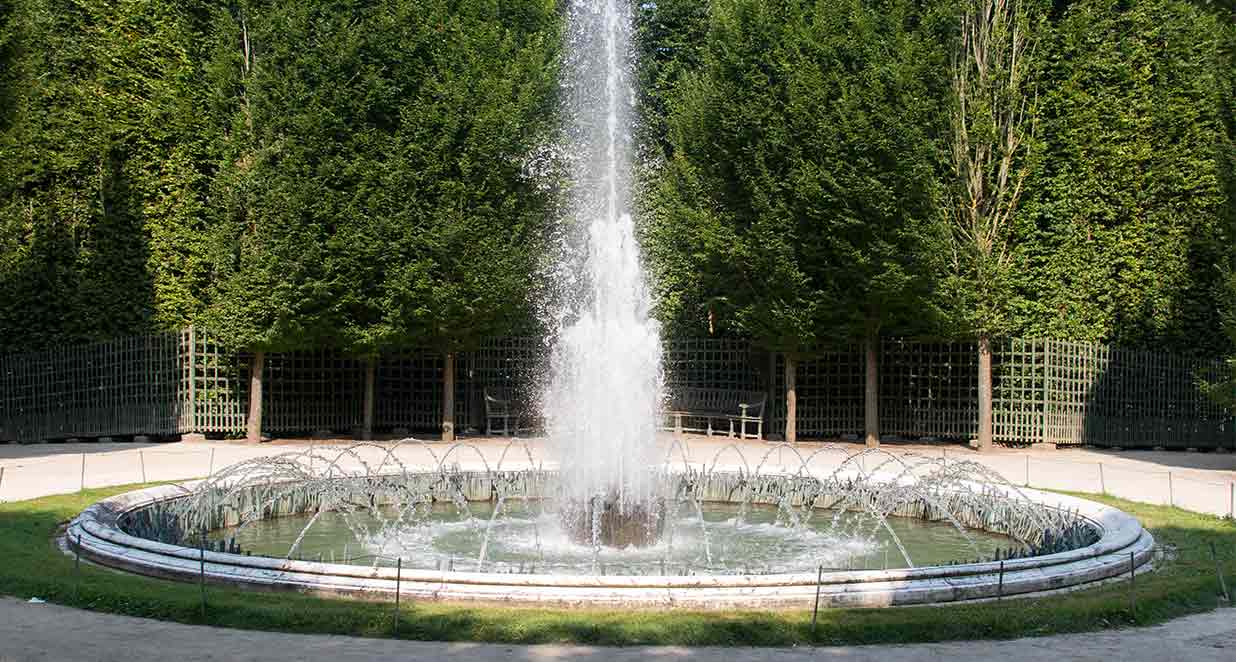
The Dauphin’s Grove
The Dauphin's Grove, also known as “The Two Groves” along with the Girandole, is one of the very first designed by André Le Nôtre around 1660. At the end of the 17th century, the sculptor Théodon completed the series of sculptures dedicated to the seasons and mythological gods.
Starting June 12th, the arboretum will be open daily from 9 am to 7 pm.
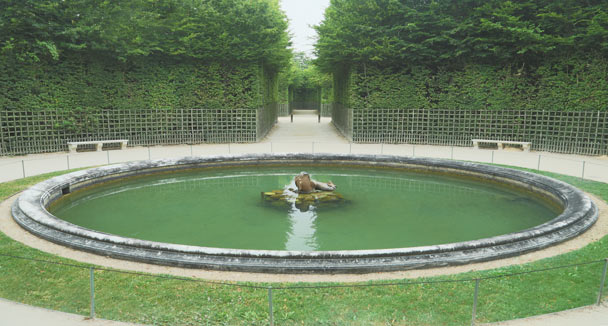
Apollo's Fountain
The original pool here was extended during the reign of Louis XIV and, in 1671, decorated with the famous gilded lead sculpture of Apollo on his chariot. The work was created by Jean-Baptiste Tuby after a drawing by Charles Le Brun and is inspired by the legend of the Sun god, the king’s emblem.
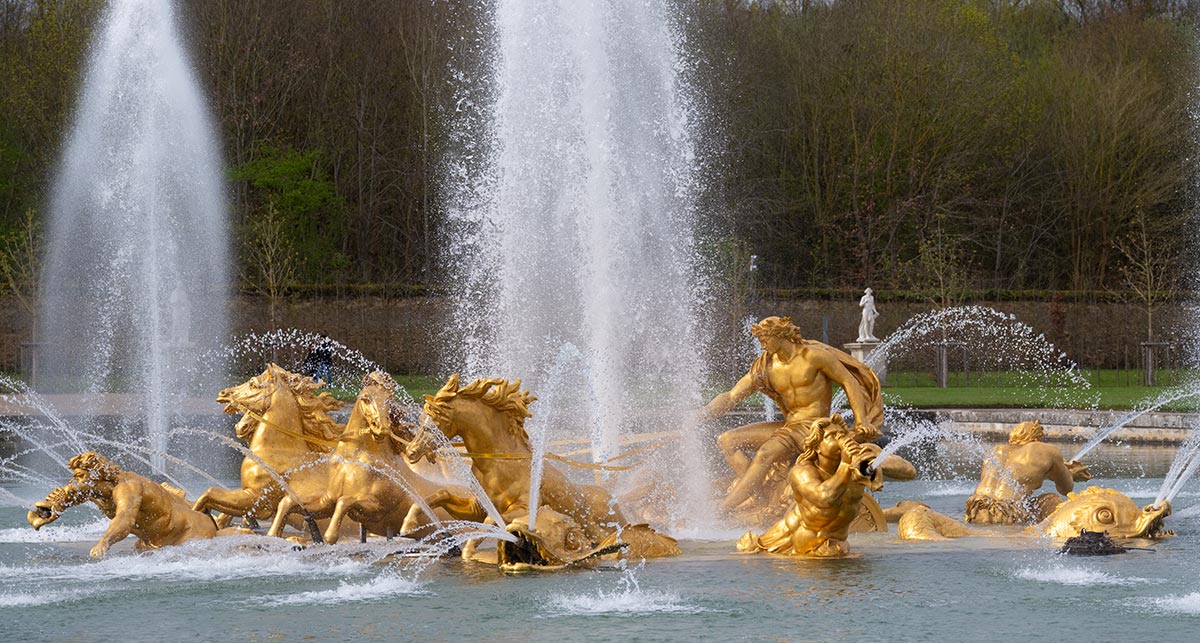
Neptune Fountain
The Neptune Fountain was made between 1679 and 1681 by Le Nôtre and was originally called “Lake Below the Dragon” or “Lake of the Pines”. The design was modified slightly in 1736 by Ange-Jacques Gabriel and the sculpted decoration glorifying the god of the sea was added in 1740. The new fountain, inaugurated by Louis XV, is composed of 99 water jets.
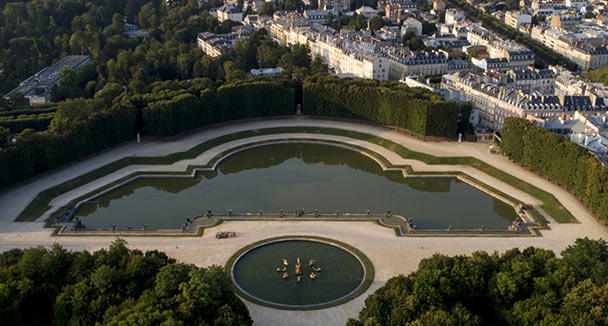
Flora Fountain
The Flora Fountain is located at the crossroads of several groves, including the Queen's Grove. Flora is the Roman goddess of flowers, gardens and springtime, and the fountain symbolises the first season of the year. Sculpted by Jean-Baptiste Tuby, the goddess can be found at the centre of the fountain, wearing a floral crown.

Saturn Fountain
Entirely in symmetry with the Flora Fountain, the Saturn Fountain in the south of the gardens was sculpted by François Girardon and symbolises winter. Saturn sits on a throne in the centre, surrounded by cupids, on an island dotted with seashells.
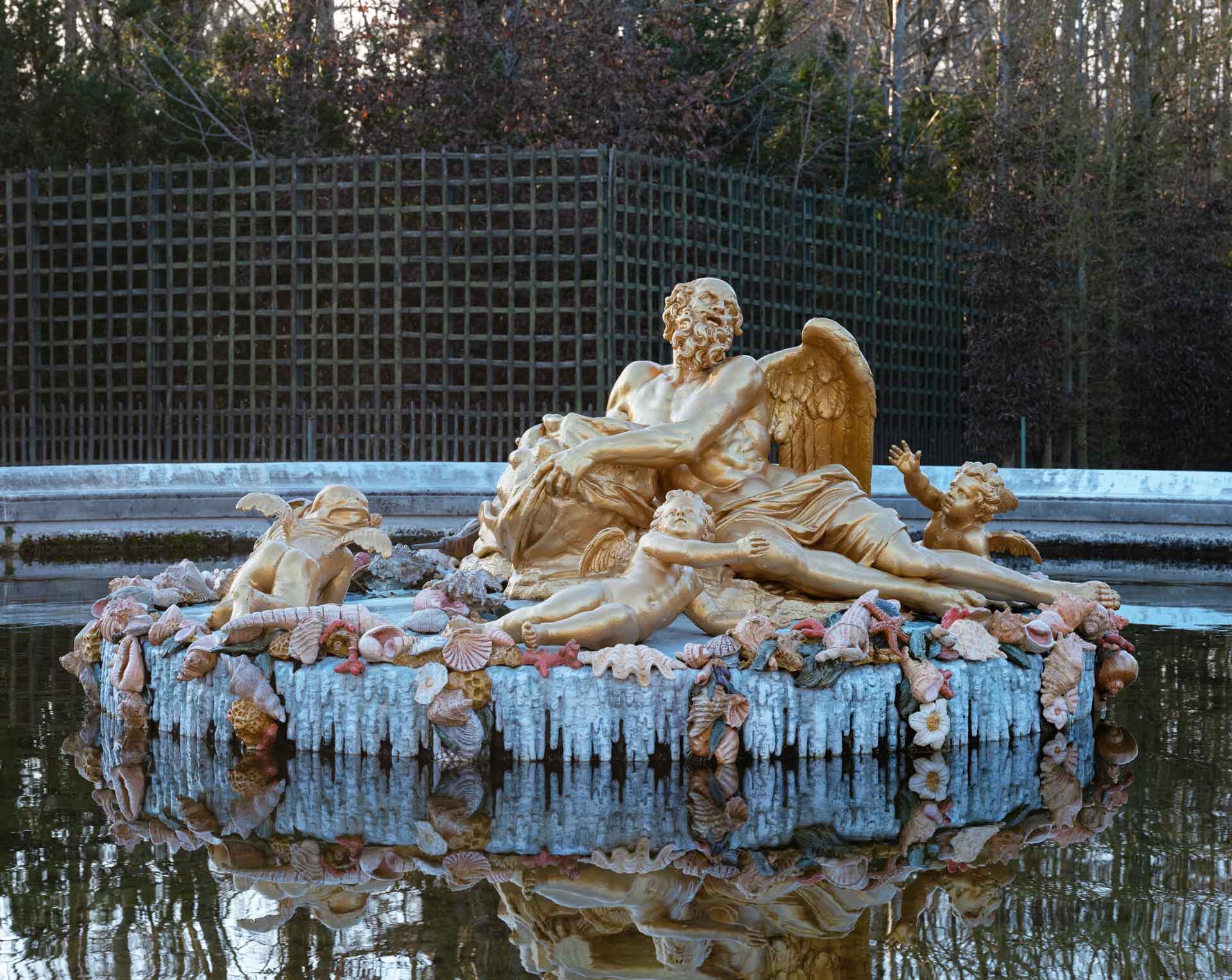
Mirror Pool
Built opposite the King's Garden, the Mirror Pool was commissioned by Louis XIV in around 1702. Built over three levels, it is framed by two dragons sculpted by Jean Hardy. Five paths lead to it, giving it an even more impressive appearance when seen from above.
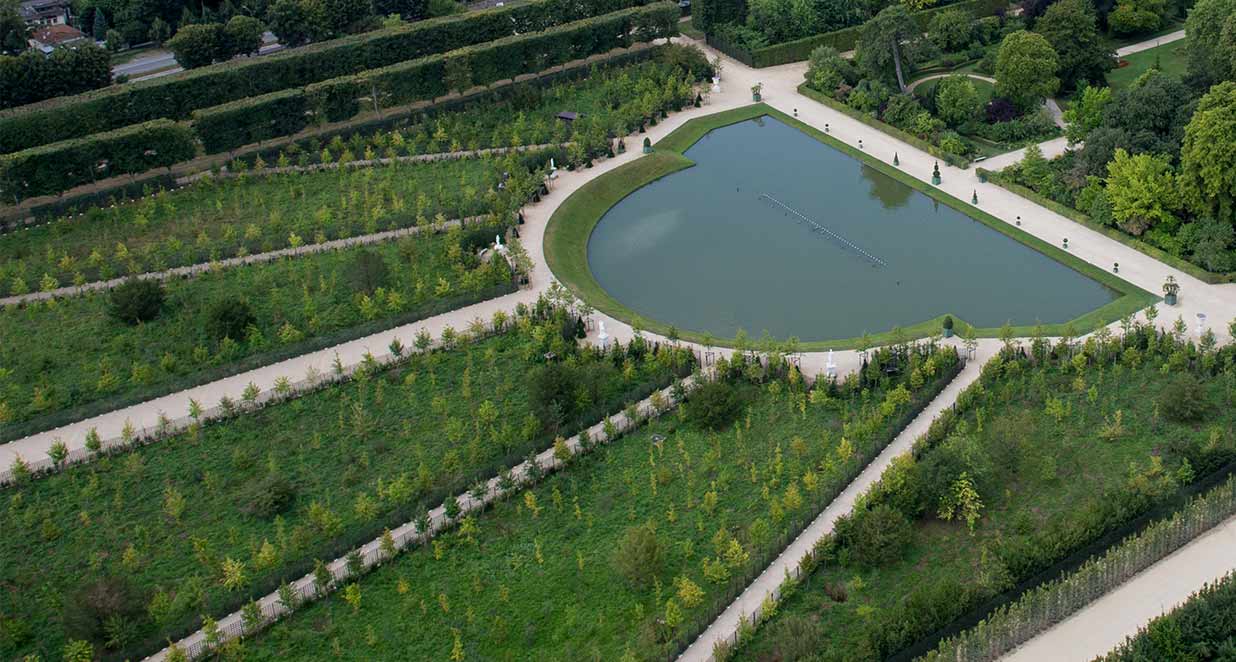
Ballroom
Created by André Le Nôtre between 1680 and 1683, the Ballroom (also called the Rococo Grove after the gritstone and shells which the water cascades over) once featured a marble “island” in its centre. This island was used as a stage for dancing, an art at which Louis XIV excelled.
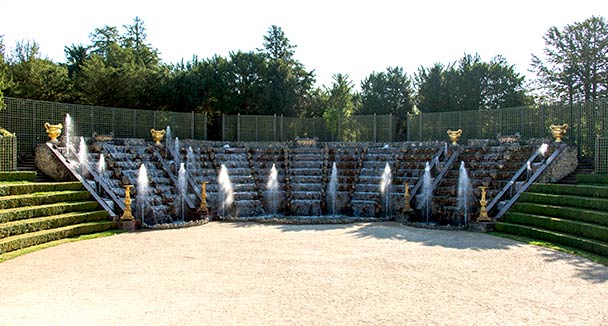
The Colonnade Grove
The construction of the Colonnade Grove started in 1685 under the direction of Jules Hardouin-Mansart, replacing the Spring Grove built by Le Nôtre in 1679. It takes its name from the peristyle composed of 32 marble columns surrounding the group of sculpted figures of the Abduction of Proserpina by François Girardon, made between 1678 and 1699.
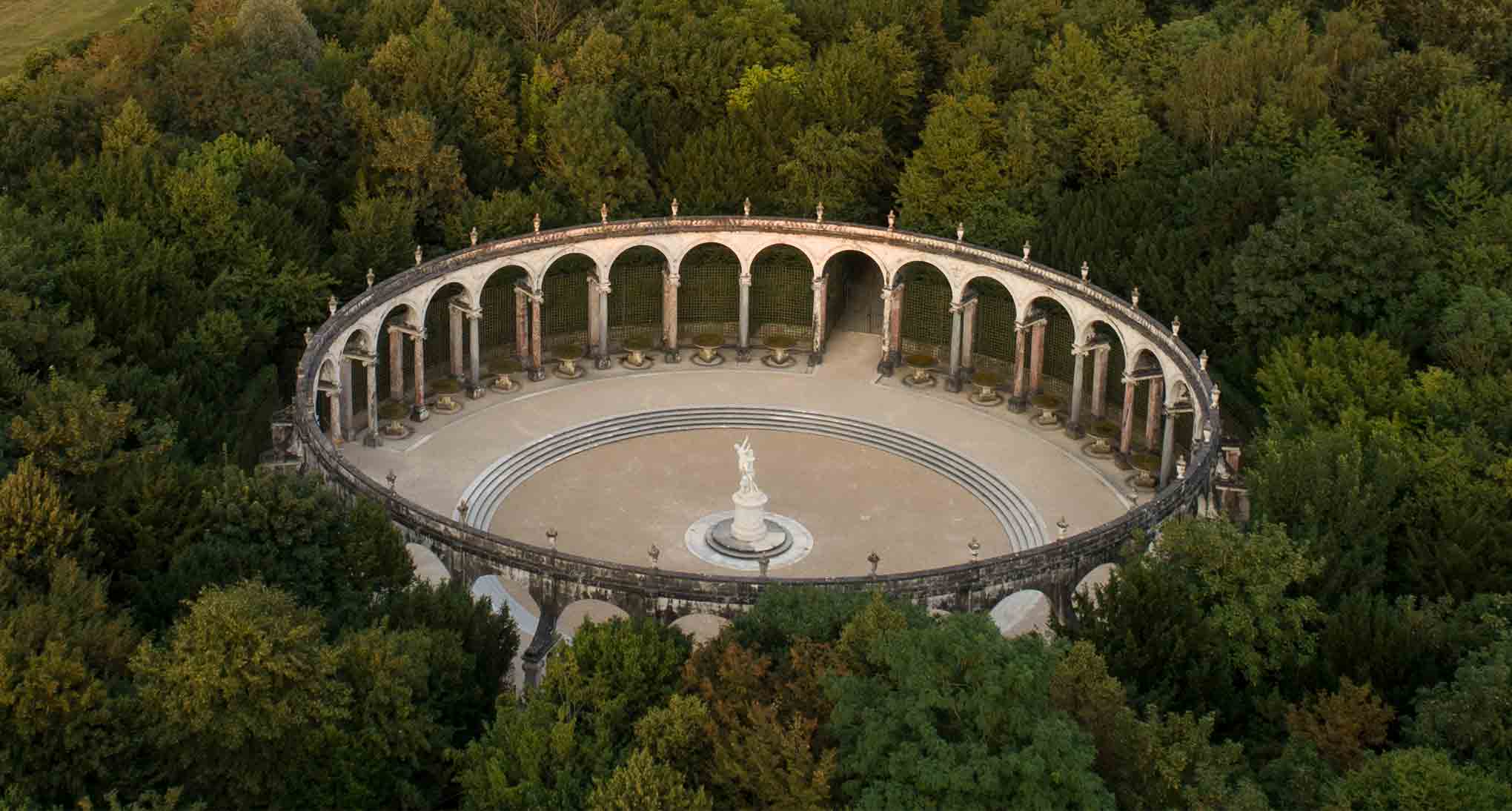
Queen's Grove
Constructed on the site of the former Maze created by Charles Perrault, the Queen's Grove was specially created in 1776 for Queen Marie-Antoinette, so that she would have somewhere to walk, away from visitors. It was originally designed in the landscaped style that was popular in the gardens of the 18th century. To create this flower garden, several non-native, particularly North American, species introduced to France in the 18th century, such as the Virginia tulip tree and white fringetree, were acclimated.
Following a two-year restoration effort, the Queen’s Grove has been unveiled to the public on 14 June 2021.
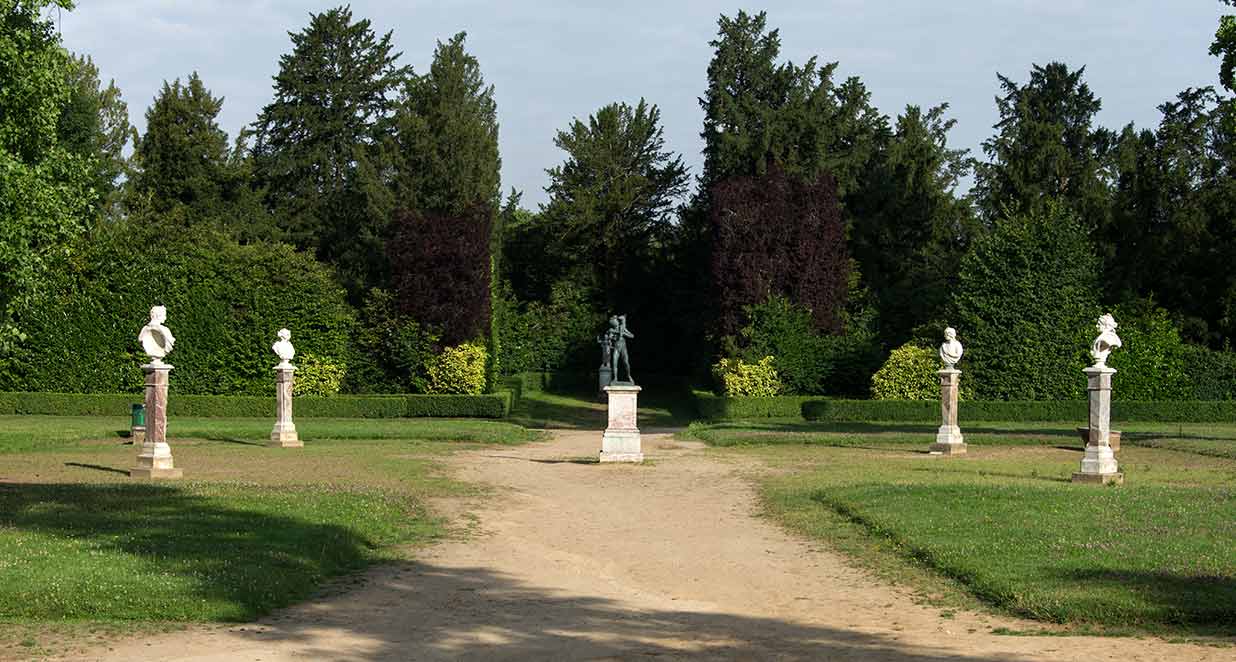
King's Garden
The architect Dufour created the enclosed King's Garden in 1817, under orders from Louis XVIII, in an English style with many superb varieties that were sadly largely destroyed in the storm of 1999. Only the original installation of the Mirror Fountain now remains.
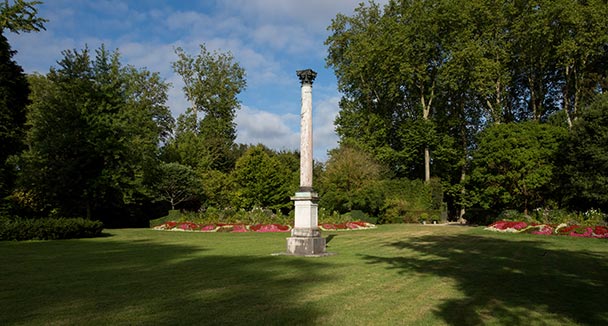
Nymphs' Bath
This fountain takes its name from the central bas-relief carved by François Girardon, called the Nymphs’ Bath. Originally gilded and sculpted in lead after a drawing by Charles Le Brun, the work represents female divinities associated with nature playing amid reeds.

Grove Of The Domes
Built by André Le Nôtre in 1675 and modified in 1677 by Jules Hardouin-Mansart, this grove owes its name to two former white marble pavilions crowned with domes that were destroyed in 1820. It has an amphitheatre design with the central “arena” occupied by a hexagonal pool surrounded by a balustrade, and a white marble basin in the centre supported by dolphins.
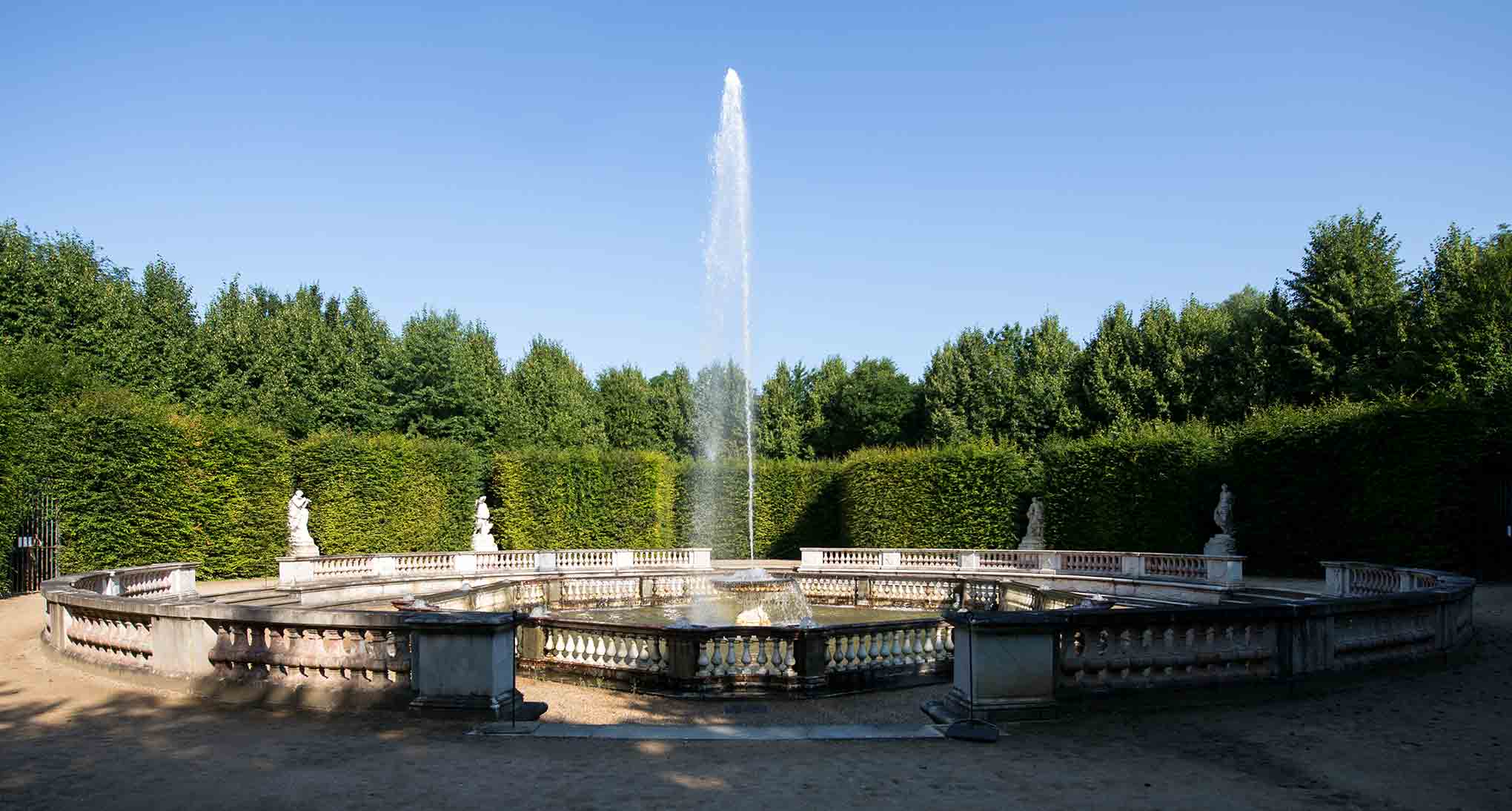
The Enceladus Grove
The Enceladus Fountain was made of lead by Gaspard Marsy between 1675 and 1677, and was inspired by the legend of the fall of the Giants in Greek and Roman mythology. Punished for trying to climb Mount Olympus to dethrone the gods, they were buried under a heap of rocks, as illustrated here by the figure of Enceladus, whose suffering is conveyed by the powerful water jet gushing out of his mouth like a cry of pain.
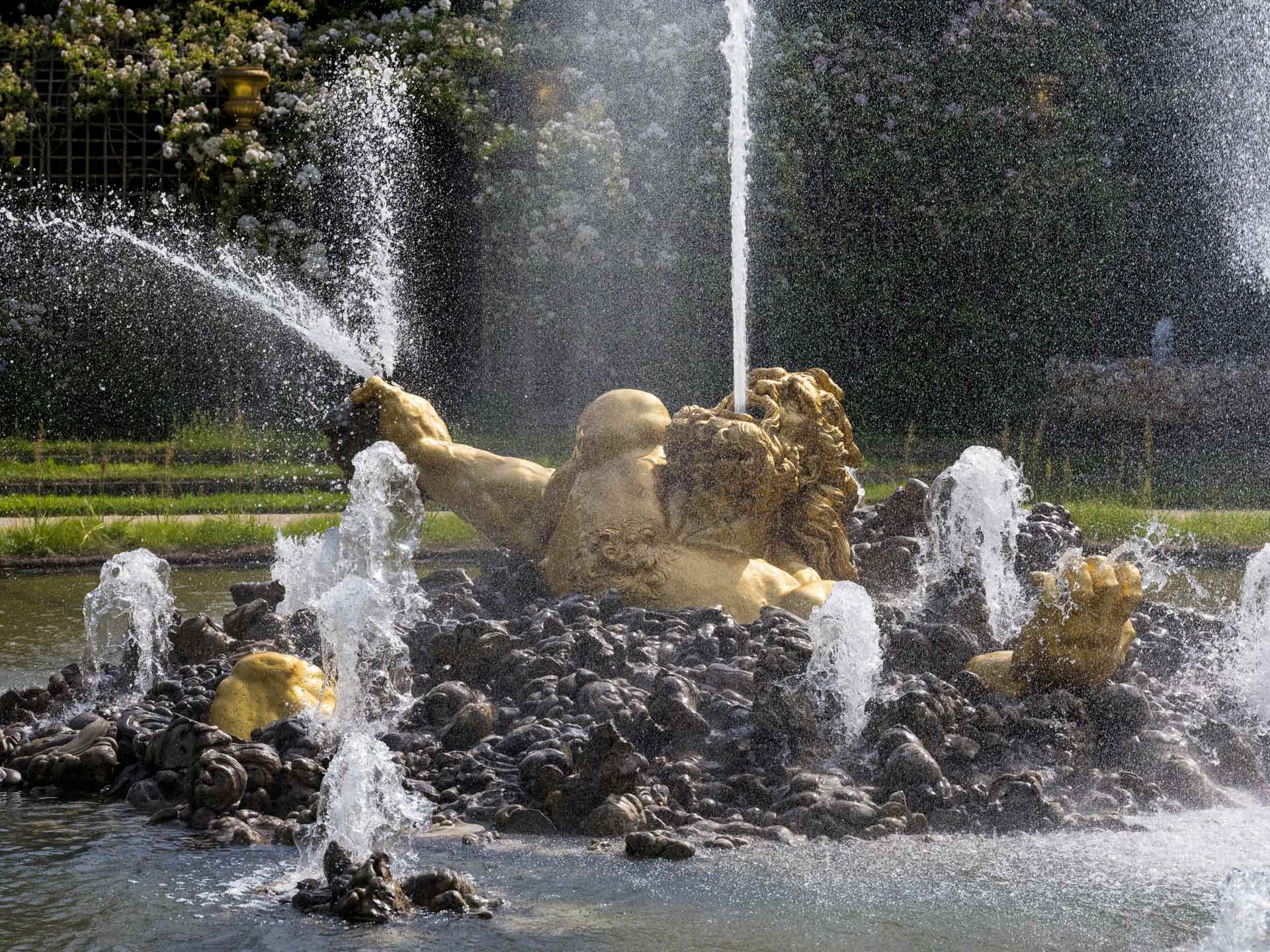
Water Theatre Grove
Landscape artist Louis Benech and artist Jean-Michel Othoniel have created a permanent contemporary artwork for Water Theatre Grove.
Open every day - Access only from the Neptune fountain and North Parterre side.
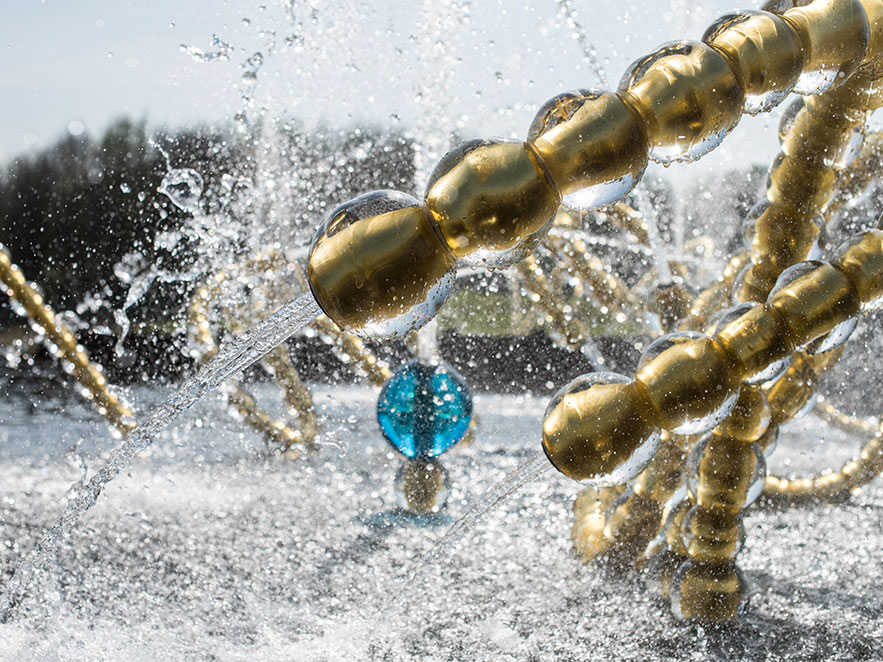
Star Grove
This grove was one of the first to be laid out by André Le Nôtre in the northern section of the gardens in 1666. The original design no longer exists.
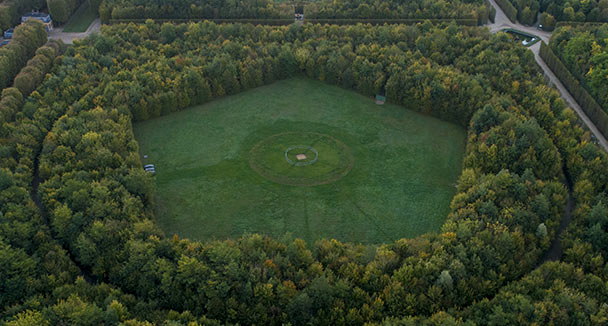
The Obelisk Grove
The Obelisk Fountain was built by Jules Hardouin-Mansart in 1704 to replace the old Feasting Chamber Grove, or Council Grove, created by Le Nôtre in 1671. The fountain is composed of a large square pool built over two levels, with an imposing spray of 230 water jets shooting up from its centre.

Grove Of The Three Fountains
Built by Le Nôtre in 1677, this is the only grove mentioned on an old map as being “designed by the king”. Running parallel to the Water Walk, it is laid out over three distinct levels linked by cascades. Restored in 2005, it recovered its design and the water effects desired by the sovereign: in the lower pool, the water jets form a fleur-de-lys, in the middle one a watery vault, and in the upper pool a water column formed by 140 water jets.
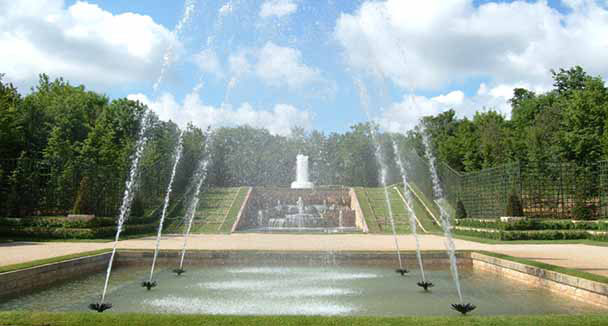
Bacchus Fountain
Also known as the autumn fountain, it is the equal of the three other fountains dedicated to the seasons located close to the Royal Walk. The mythological Roman figure Bacchus spread the cultivation of vines throughout the world. God of wine and intoxication, he symbolises the grape harvest and is surrounded by small satyrs - half children, half goat.
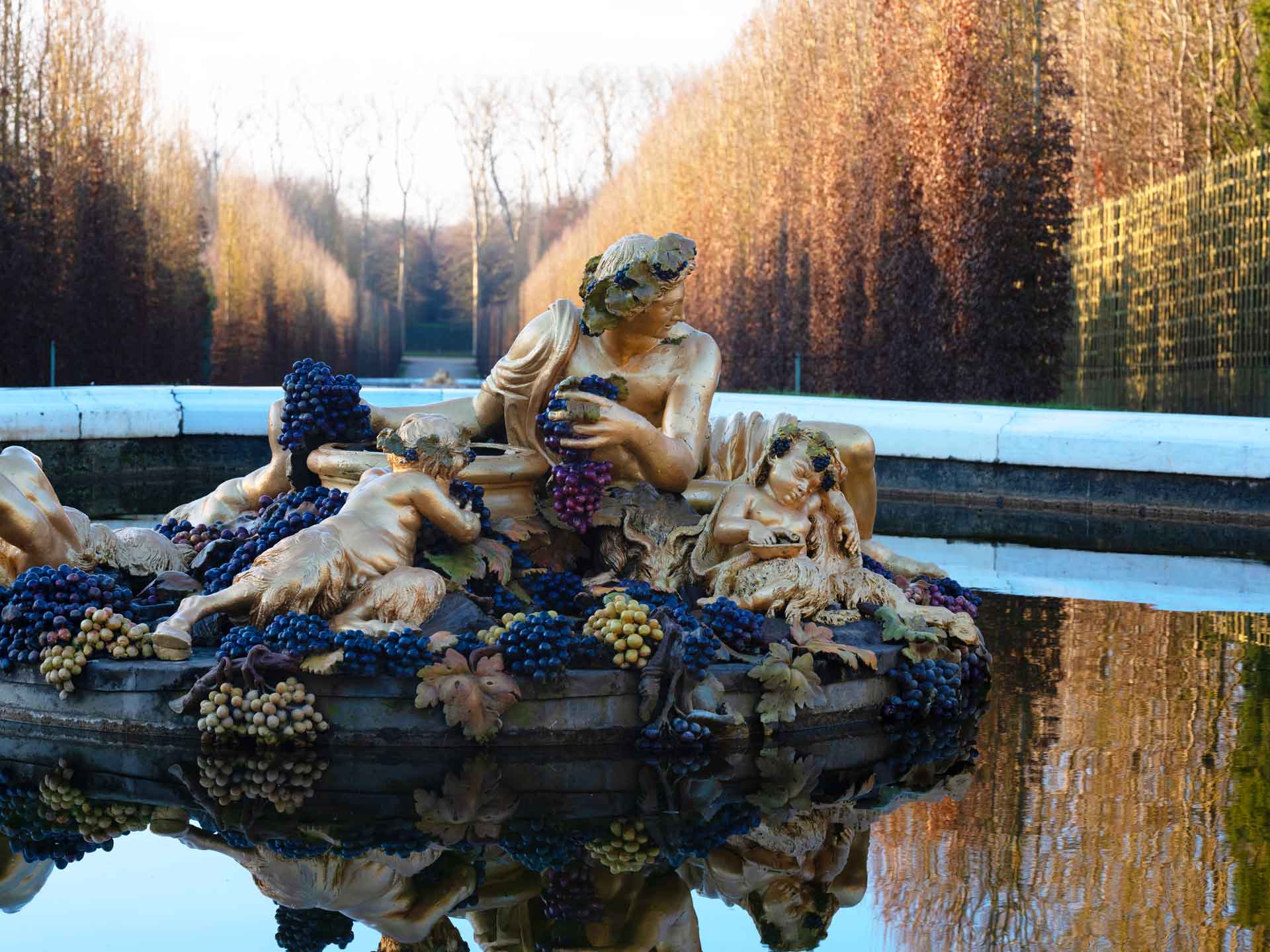
Ceres Fountain
The square Ceres fountain was laid out between 1672 and 1679 by Thomas Regnaudin from a drawing by Charles Le Brun. Ceres, the Roman goddess of harvests, is seated on a bed of corn stalks, surrounded by cornflowers and roses. Symbolising summer, the fountain forms a group with those of Bacchus, Flora and Saturn, which represent the other three seasons.
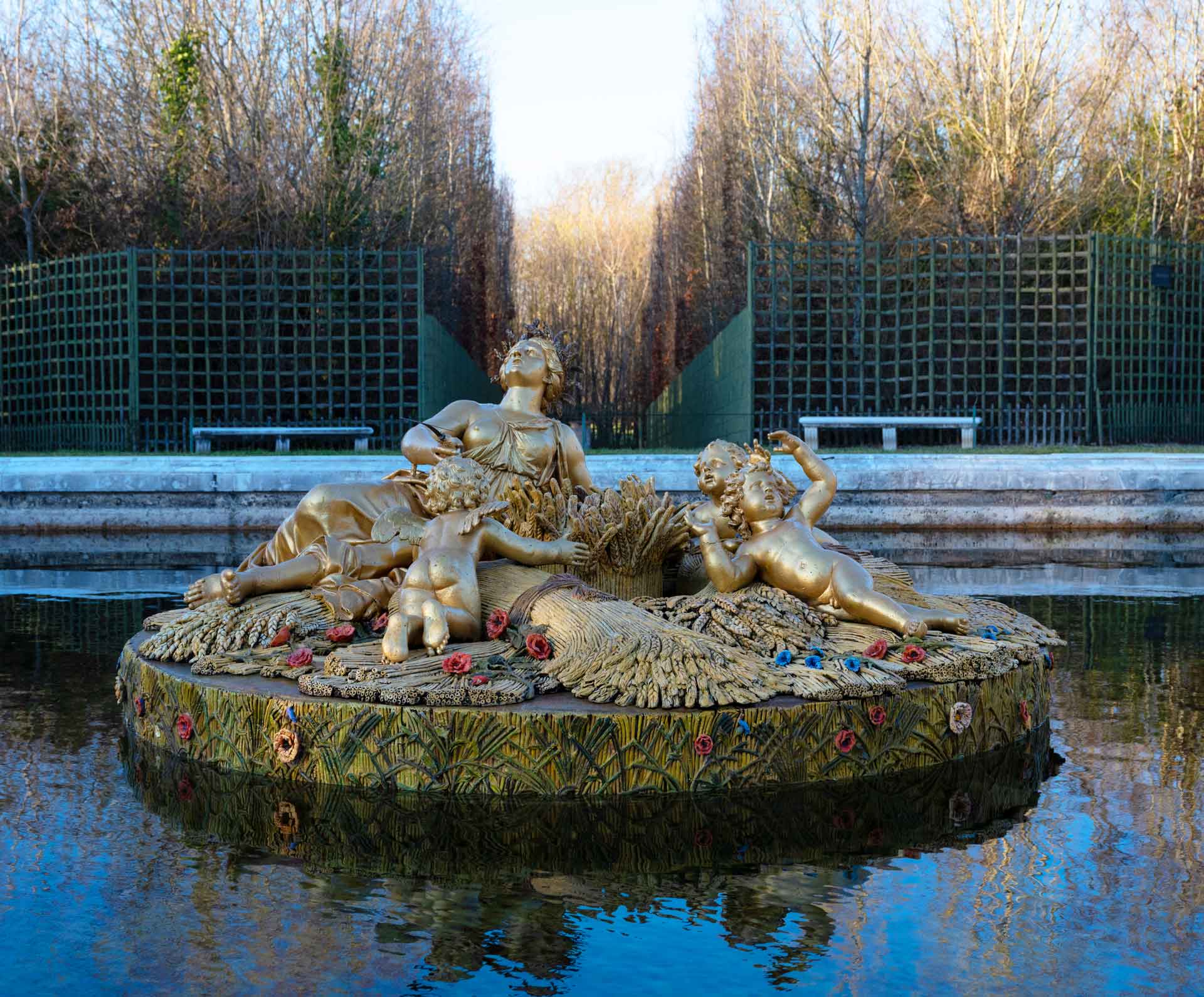
Triumphal Arch Grove
Today, only one fountain remains in this grove completed between 1679 and 1683: Triumphal France made of gilded lead by the sculptors Antoine Coysevox, Jean-Baptiste Tuby and Jacques Prou. During the reign of Louis XIV, this verdant grove also contained a large triumphal arch made of gilded metal gleaming with water jets and cascades.
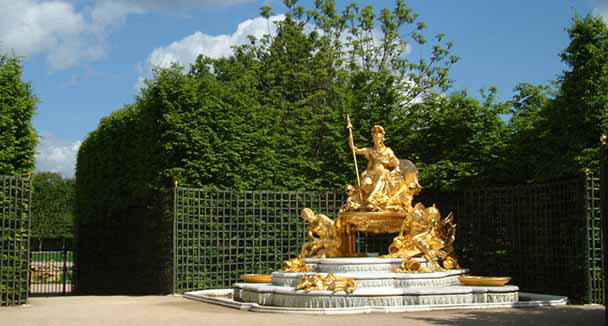
Great Lawn
Also known as the "Royal Walk", it gets its name from the expanse of grass that runs down the middle, the Great Lawn, that measures 335 metres in length and 40 metres in width. It was laid down under Louis XIII, but André Le Nôtre widened it and lined it with twelve statues and twelve vases, for the most part works sent by the Académie de France in Rome in the 17th century.
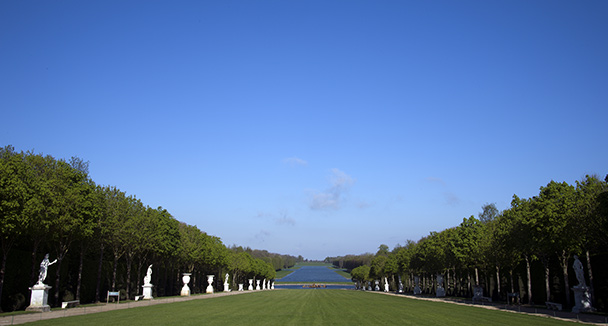
Dawn Fountain
The Point du Jour Fountain is decorated with animals in combat (a bloodhound attacking a stag and a tiger bringing down a bear) created by Houzeau. It is framed by three statues: Water by Le Gros (1681); Springtime by Magnier (1681); Le Point du Jour by Marsy (1680).

Night Fountain
The Evening Fountain is decorated with animals in combat (a lion bringing down a wolf and a lion bringing down a boar) created by Corneille Van Clève and Jean Raon. It is framed by three statues: Evening by Desjardins (1680); L'Heure de Midi by G. Marsy (1680) and Air by Le Hongre (1685).
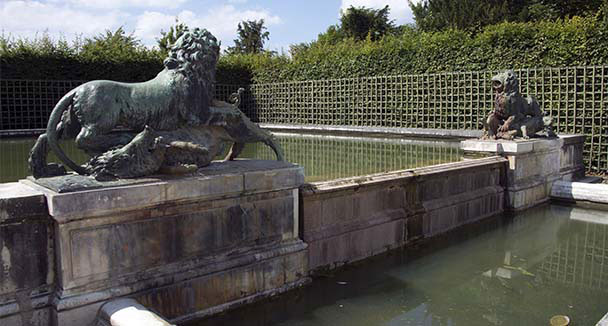
The Grand Canal
Dug between 1668 and 1679, the Grand Canal was André Le Nôtre’s most original creation. Covering an area of 23 hectares, measuring 60m wide and stretching out 1700m from east to west and 1000m from north to south, it allows the beauty and scale of the Estate to be admired in one go. Its dimensions were carefully calculated by Louis XIV’s architect to create the perfect perspective.
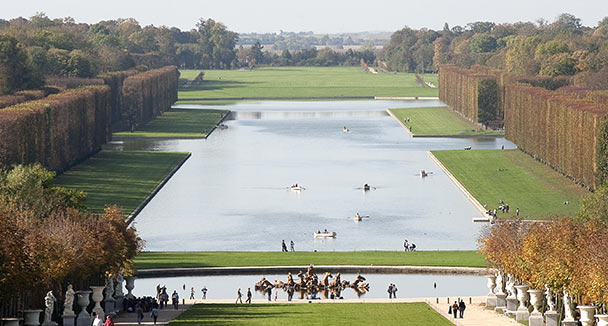
Golden Children's Pool
Situated on the edge of the Water Theatre Grove, the Golden Children’s Pool was built in 1709 by Jules Hardouin-Mansart. This small, elliptical pool is decorated with a central group of eight cherubim sculpted in lead by Jean Hardy. It was restored in 2016.
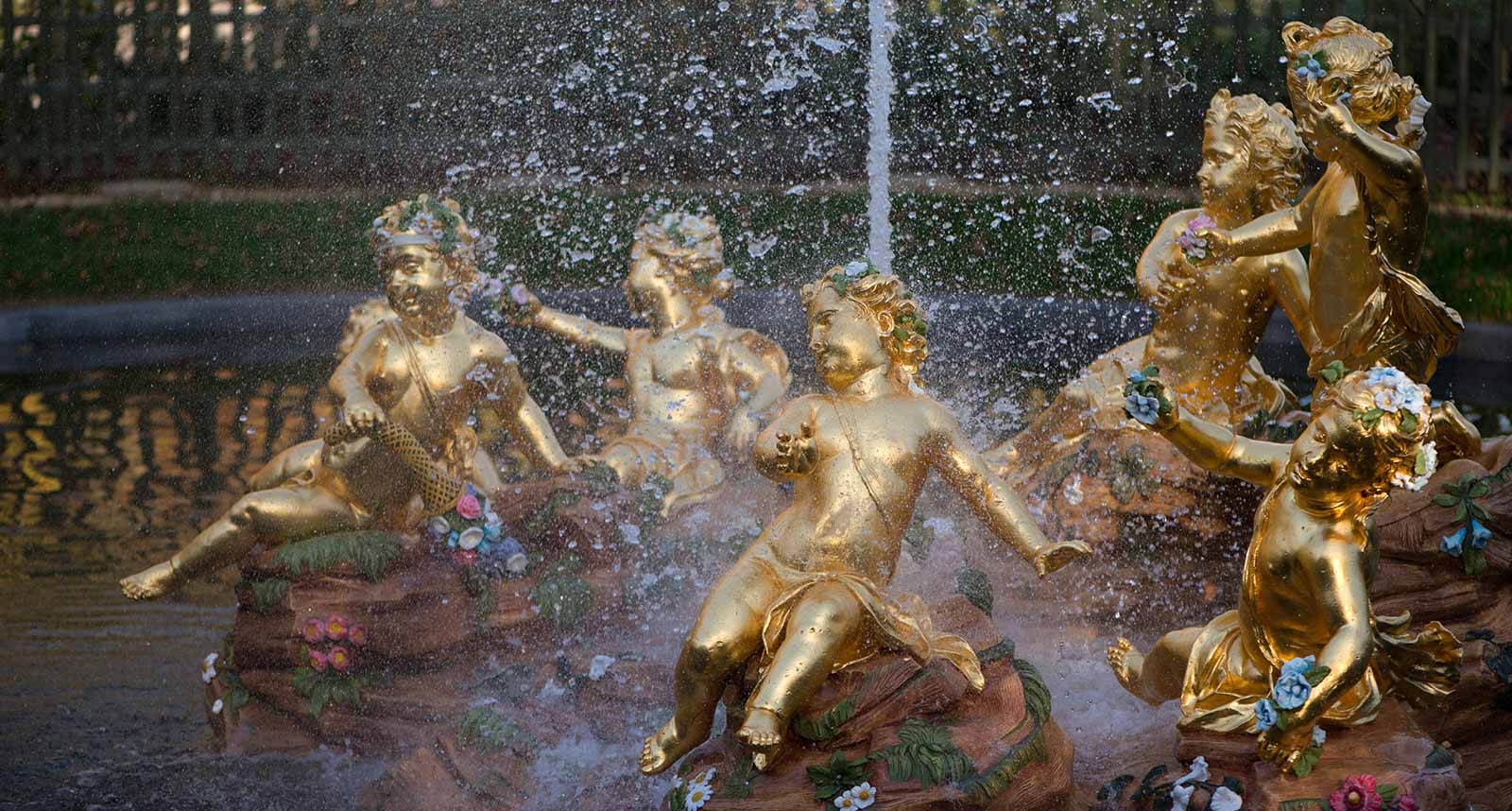
The King’s Viewpoint
In the footsteps of Louis XIV, the “King’s Viewpoint” affords a view of all four Seasons Fountains with a simple turn of the head: Flora (Spring), Ceres (Summer), Bacchus (Autumn) and Saturn (Winter). Although not an easy task, the reward is worth the effort!
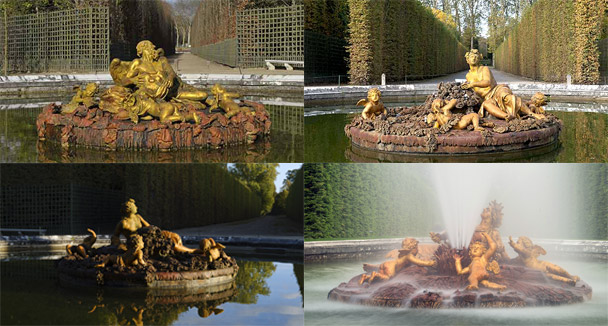
The Palace Terrace
The Palace terrace affords a unique view over the Grand Canal without the optical effect designed by André Le Nôtre, from which came the name “Grande Perspective”. It can be admired in full from the top of the steps leading to Latona's Fountain.
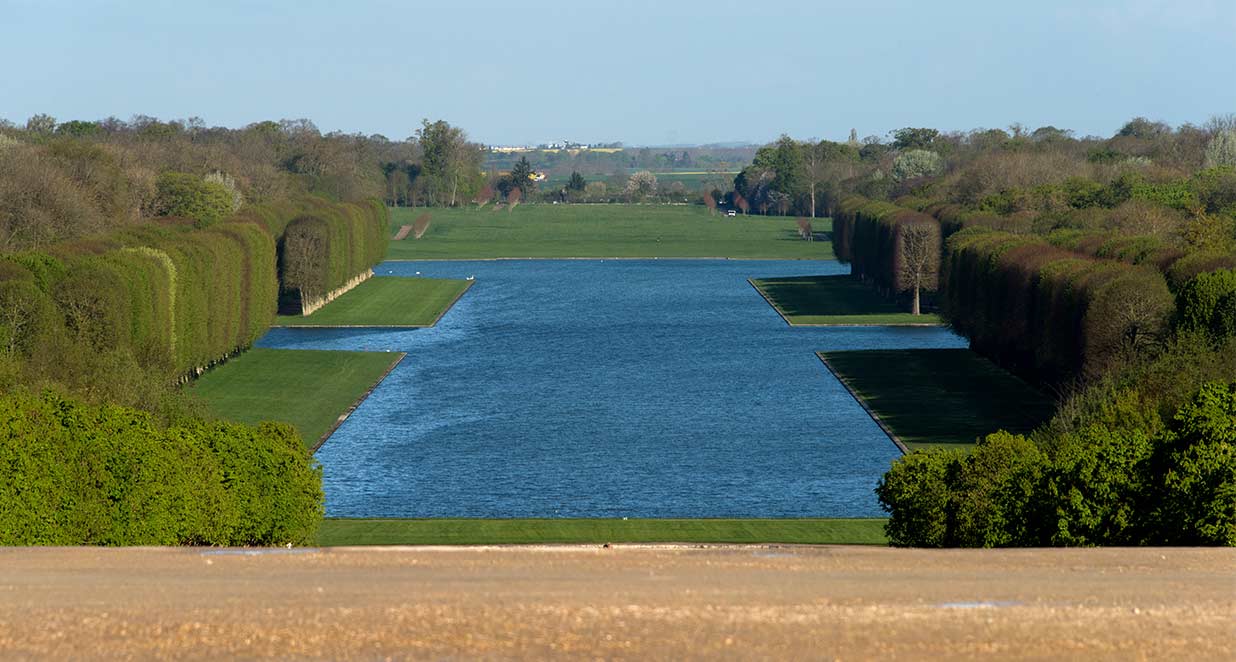
Sphinx Ridden By A Putto
This group, depicting a putto straddling a sphinx, dates back to 1667/68 and is one of the oldest in the gardens. Made from marble and bronze, it was created by Jacques Houzeau, Louis Lerambert and founder Ambroise Duval, after a work by Jacques Sarazin.
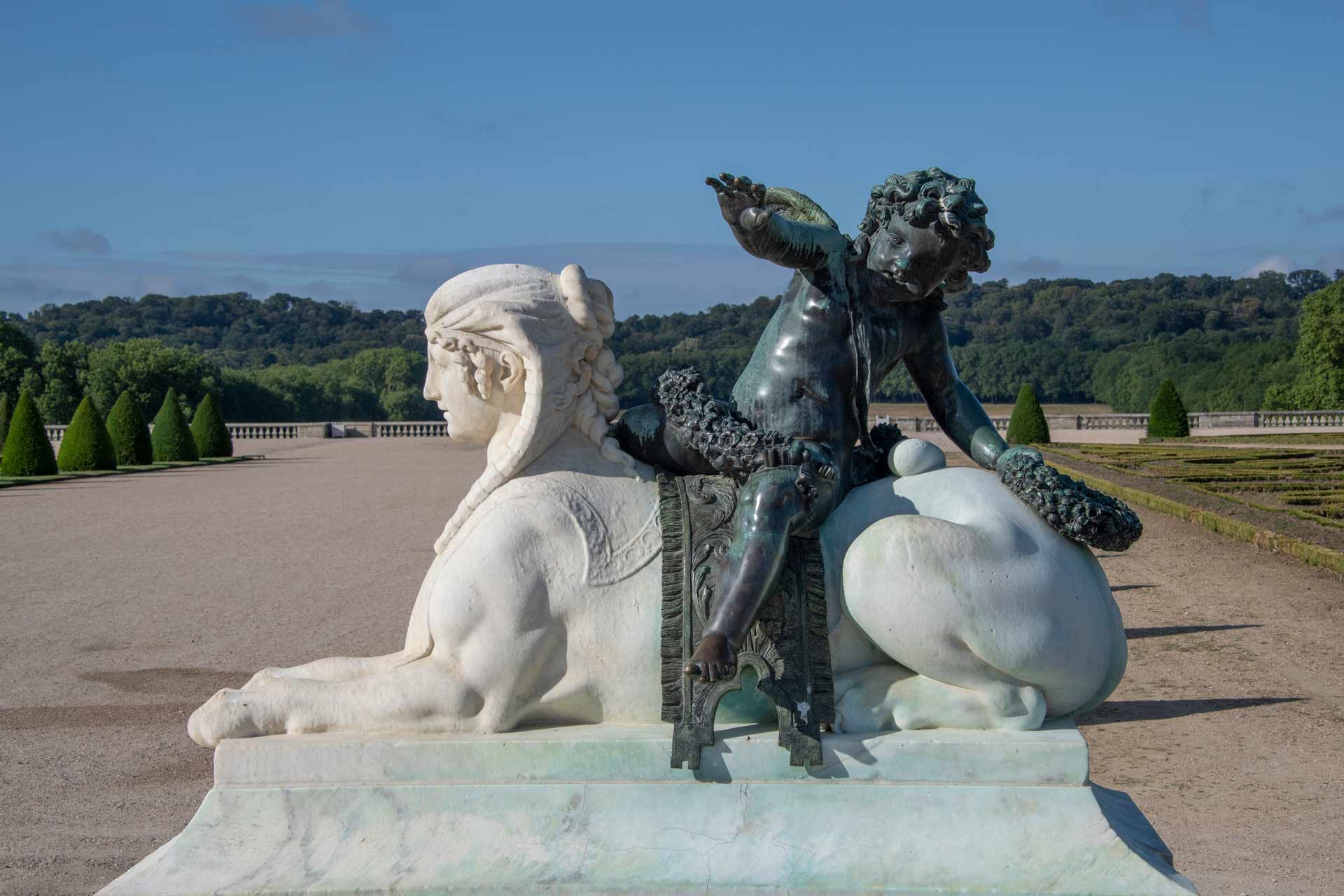
Where can I admire the Grand Perspective ?
We recommend viewing it from the Water Parterre at the top of the Latona Fountain steps.
Water Garden
The Water Garden appears to be an extension of the facade of the Palace. Their layout was modified several times before receiving its definitive form, in 1685. Each pool is decorated with statues of lying-down figures representing the rivers of France, accompanied by nymphs and children.

Latona's Fountain
This group of sculpted marble figures of Latona and her children is one of the most famous works of Versailles, made in 1670 by the Marsy brothers and lending its name to the fountain on which it proudly stands. Inspired by Ovid’s Metamorphoses, Latona's Fountain illustrates the transformation of the Lycian peasants into amphibians after they prevented the goddess and her children, Diana and Apollo, from quenching their thirst. The pool and parterre surrounding the fountain, designed by André Le Nôtre, were fully restored in 2015.

Apollo's Fountain
The original pool here was extended during the reign of Louis XIV and, in 1671, decorated with the famous gilded lead sculpture of Apollo on his chariot. The work was created by Jean-Baptiste Tuby after a drawing by Charles Le Brun and is inspired by the legend of the Sun god, the king’s emblem.

Great Lawn
Also known as the "Royal Walk", it gets its name from the expanse of grass that runs down the middle, the Great Lawn, that measures 335 metres in length and 40 metres in width. It was laid down under Louis XIII, but André Le Nôtre widened it and lined it with twelve statues and twelve vases, for the most part works sent by the Académie de France in Rome in the 17th century.

The Grand Canal
Dug between 1668 and 1679, the Grand Canal was André Le Nôtre’s most original creation. Covering an area of 23 hectares, measuring 60m wide and stretching out 1700m from east to west and 1000m from north to south, it allows the beauty and scale of the Estate to be admired in one go. Its dimensions were carefully calculated by Louis XIV’s architect to create the perfect perspective.

Where are the groves located?
The Queen's Grove, The Ballroom Grove, The Girandole Grove… these are all masterpieces found on either side of the Grand Perspective. Certain groves are only open on Fountain Show and Musical Gardens days, except for the Water theater Grove which is opened all year.
Apollo’s Baths Grove
The current grove dates from the reign of Louis XVI and was built between 1778 and 1781. The central pool is overlooked by a large artificial rock decorated with waterfalls and hollow caves. It houses the sculpted groups of The Horses of the Sun standing either side of Apollo Served by Nymphs, by François Girardon and Thomas Regnaudin.

The Girandole Grove
The Girandole Grove, which forms a pair with the Dauphin Grove, has seen few modifications since its creation. It is decorated with terms commissioned by Nicolas Fouquet, once Superintendent of Finances to Louis XIV, for the Château of Vaux-le-Vicomte and made in Rome after models by Poussin.

The Dauphin’s Grove
The Dauphin's Grove, also known as “The Two Groves” along with the Girandole, is one of the very first designed by André Le Nôtre around 1660. At the end of the 17th century, the sculptor Théodon completed the series of sculptures dedicated to the seasons and mythological gods.
Starting June 12th, the arboretum will be open daily from 9 am to 7 pm.

Ballroom
Created by André Le Nôtre between 1680 and 1683, the Ballroom (also called the Rococo Grove after the gritstone and shells which the water cascades over) once featured a marble “island” in its centre. This island was used as a stage for dancing, an art at which Louis XIV excelled.

The Colonnade Grove
The construction of the Colonnade Grove started in 1685 under the direction of Jules Hardouin-Mansart, replacing the Spring Grove built by Le Nôtre in 1679. It takes its name from the peristyle composed of 32 marble columns surrounding the group of sculpted figures of the Abduction of Proserpina by François Girardon, made between 1678 and 1699.

Chestnut Room
Laid out between 1680 and 1683, the Chestnut Room was formerly known as the Gallery of Antiques or Water Gallery, featuring a central avenue lined with orange trees, sculpted yew trees, ponds and fountains. In 1704, the grove became the Chestnut Room, decorated with eight antique busts and two statues.
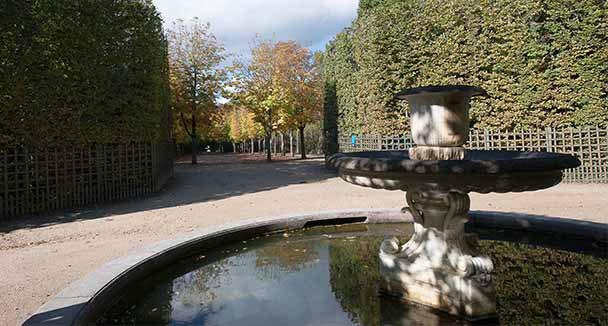
Queen's Grove
Constructed on the site of the former Maze created by Charles Perrault, the Queen's Grove was specially created in 1776 for Queen Marie-Antoinette, so that she would have somewhere to walk, away from visitors. It was originally designed in the landscaped style that was popular in the gardens of the 18th century. To create this flower garden, several non-native, particularly North American, species introduced to France in the 18th century, such as the Virginia tulip tree and white fringetree, were acclimated.
Following a two-year restoration effort, the Queen’s Grove has been unveiled to the public on 14 June 2021.

King's Garden
The architect Dufour created the enclosed King's Garden in 1817, under orders from Louis XVIII, in an English style with many superb varieties that were sadly largely destroyed in the storm of 1999. Only the original installation of the Mirror Fountain now remains.

Grove Of The Domes
Built by André Le Nôtre in 1675 and modified in 1677 by Jules Hardouin-Mansart, this grove owes its name to two former white marble pavilions crowned with domes that were destroyed in 1820. It has an amphitheatre design with the central “arena” occupied by a hexagonal pool surrounded by a balustrade, and a white marble basin in the centre supported by dolphins.

The Enceladus Grove
The Enceladus Fountain was made of lead by Gaspard Marsy between 1675 and 1677, and was inspired by the legend of the fall of the Giants in Greek and Roman mythology. Punished for trying to climb Mount Olympus to dethrone the gods, they were buried under a heap of rocks, as illustrated here by the figure of Enceladus, whose suffering is conveyed by the powerful water jet gushing out of his mouth like a cry of pain.

Water Theatre Grove
Landscape artist Louis Benech and artist Jean-Michel Othoniel have created a permanent contemporary artwork for Water Theatre Grove.
Open every day - Access only from the Neptune fountain and North Parterre side.

Star Grove
This grove was one of the first to be laid out by André Le Nôtre in the northern section of the gardens in 1666. The original design no longer exists.

The Obelisk Grove
The Obelisk Fountain was built by Jules Hardouin-Mansart in 1704 to replace the old Feasting Chamber Grove, or Council Grove, created by Le Nôtre in 1671. The fountain is composed of a large square pool built over two levels, with an imposing spray of 230 water jets shooting up from its centre.

Grove Of The Three Fountains
Built by Le Nôtre in 1677, this is the only grove mentioned on an old map as being “designed by the king”. Running parallel to the Water Walk, it is laid out over three distinct levels linked by cascades. Restored in 2005, it recovered its design and the water effects desired by the sovereign: in the lower pool, the water jets form a fleur-de-lys, in the middle one a watery vault, and in the upper pool a water column formed by 140 water jets.

Triumphal Arch Grove
Today, only one fountain remains in this grove completed between 1679 and 1683: Triumphal France made of gilded lead by the sculptors Antoine Coysevox, Jean-Baptiste Tuby and Jacques Prou. During the reign of Louis XIV, this verdant grove also contained a large triumphal arch made of gilded metal gleaming with water jets and cascades.

Where is the Orangerie located? Where are the parterres?
At the foot of the Palace, the Orangerie is one of the best examples of Jules Hardouin-Mansart's great talent as an architect, due to its size, its height and the purity of its alignments. Orange trees from Portugal, Spain and Italy and lemon and pomegranate trees. Some of the trees are over 200 years old. During winter, pink laurels and palm trees are kept there.
During the Fountains Night Show visitors can enter in the Orangerie.
North Parterre
The North Parterre, situated in front of the King's Grand Apartment, is surrounded by eighteen sculptures, of which fifteen date back to the great commission of 1674. The iconography evokes the myth of Apollo and his nurturing and influential journey around the globe.

Water Garden
The Water Garden appears to be an extension of the facade of the Palace. Their layout was modified several times before receiving its definitive form, in 1685. Each pool is decorated with statues of lying-down figures representing the rivers of France, accompanied by nymphs and children.

South Garden
Formerly known as the Flowers Parterre, the South Garden is situated above the Orangerie. During the reign of Louis XIV, brightly-coloured flowers were continually planted and replanted here: wallflowers, hyacinths, jasmine, tulips...

The Orangery Garden

Latona's Fountain
This group of sculpted marble figures of Latona and her children is one of the most famous works of Versailles, made in 1670 by the Marsy brothers and lending its name to the fountain on which it proudly stands. Inspired by Ovid’s Metamorphoses, Latona's Fountain illustrates the transformation of the Lycian peasants into amphibians after they prevented the goddess and her children, Diana and Apollo, from quenching their thirst. The pool and parterre surrounding the fountain, designed by André Le Nôtre, were fully restored in 2015.

Where is the Neptune Fountain located?
Located below the Parterre Nord this fountain, inaugurated by Louis XV, was a source of admiration given the number, size and variety of its water sprays that interplay with the lead sculptures. It has ninety-nine water features comprising an extraordinary hydraulic system. The waters are turned on in this fountain for the finale of the Fountain Show.
Neptune Fountain
The Neptune Fountain was made between 1679 and 1681 by Le Nôtre and was originally called “Lake Below the Dragon” or “Lake of the Pines”. The design was modified slightly in 1736 by Ange-Jacques Gabriel and the sculpted decoration glorifying the god of the sea was added in 1740. The new fountain, inaugurated by Louis XV, is composed of 99 water jets.

Where are the other fountains?
Latona Fountain, Bacchus Fountain, Apollo Fountain, Saturn Fountain...
Even more than the plant architecture and the groves, water in all its forms is the privileged ornament in the French gardens: water cascading into certain groves, water spouting from fountains, the quiet water of the large ponds reflecting the sky and light, such as in the Water Parterre and the Grand Canal.
Dragon Fountain
The Dragon Fountain represents an episode from Apollonian legend: The young Apollo kills the serpent Python with an arrow. The reptile is surrounded by dolphins and Cupids with bows and arrows, riding on swans. The main fountain reaches twenty seven metres in height.

Latona's Fountain
This group of sculpted marble figures of Latona and her children is one of the most famous works of Versailles, made in 1670 by the Marsy brothers and lending its name to the fountain on which it proudly stands. Inspired by Ovid’s Metamorphoses, Latona's Fountain illustrates the transformation of the Lycian peasants into amphibians after they prevented the goddess and her children, Diana and Apollo, from quenching their thirst. The pool and parterre surrounding the fountain, designed by André Le Nôtre, were fully restored in 2015.

Apollo's Fountain
The original pool here was extended during the reign of Louis XIV and, in 1671, decorated with the famous gilded lead sculpture of Apollo on his chariot. The work was created by Jean-Baptiste Tuby after a drawing by Charles Le Brun and is inspired by the legend of the Sun god, the king’s emblem.

The Pyramid Fountain
Created by the sculptor François Girardon from a drawing by Charles Le Brun, the pyramid took three years to complete. It consists of four stacked lead and marble basins, supported by tritons, dolphins and crayfish in lead. Previously gilded, the sculpture is crowned by the mythological figure of Triton, worshipped by sailors.
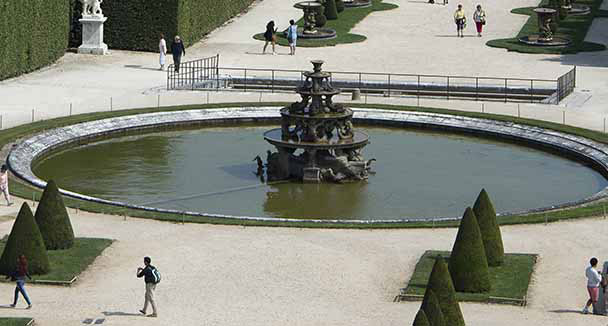
Neptune Fountain
The Neptune Fountain was made between 1679 and 1681 by Le Nôtre and was originally called “Lake Below the Dragon” or “Lake of the Pines”. The design was modified slightly in 1736 by Ange-Jacques Gabriel and the sculpted decoration glorifying the god of the sea was added in 1740. The new fountain, inaugurated by Louis XV, is composed of 99 water jets.

Flora Fountain
The Flora Fountain is located at the crossroads of several groves, including the Queen's Grove. Flora is the Roman goddess of flowers, gardens and springtime, and the fountain symbolises the first season of the year. Sculpted by Jean-Baptiste Tuby, the goddess can be found at the centre of the fountain, wearing a floral crown.

Saturn Fountain
Entirely in symmetry with the Flora Fountain, the Saturn Fountain in the south of the gardens was sculpted by François Girardon and symbolises winter. Saturn sits on a throne in the centre, surrounded by cupids, on an island dotted with seashells.

Mirror Pool
Built opposite the King's Garden, the Mirror Pool was commissioned by Louis XIV in around 1702. Built over three levels, it is framed by two dragons sculpted by Jean Hardy. Five paths lead to it, giving it an even more impressive appearance when seen from above.

Nymphs' Bath
This fountain takes its name from the central bas-relief carved by François Girardon, called the Nymphs’ Bath. Originally gilded and sculpted in lead after a drawing by Charles Le Brun, the work represents female divinities associated with nature playing amid reeds.

Bacchus Fountain
Also known as the autumn fountain, it is the equal of the three other fountains dedicated to the seasons located close to the Royal Walk. The mythological Roman figure Bacchus spread the cultivation of vines throughout the world. God of wine and intoxication, he symbolises the grape harvest and is surrounded by small satyrs - half children, half goat.

Ceres Fountain
The square Ceres fountain was laid out between 1672 and 1679 by Thomas Regnaudin from a drawing by Charles Le Brun. Ceres, the Roman goddess of harvests, is seated on a bed of corn stalks, surrounded by cornflowers and roses. Symbolising summer, the fountain forms a group with those of Bacchus, Flora and Saturn, which represent the other three seasons.

Dawn Fountain
The Point du Jour Fountain is decorated with animals in combat (a bloodhound attacking a stag and a tiger bringing down a bear) created by Houzeau. It is framed by three statues: Water by Le Gros (1681); Springtime by Magnier (1681); Le Point du Jour by Marsy (1680).

Night Fountain
The Evening Fountain is decorated with animals in combat (a lion bringing down a wolf and a lion bringing down a boar) created by Corneille Van Clève and Jean Raon. It is framed by three statues: Evening by Desjardins (1680); L'Heure de Midi by G. Marsy (1680) and Air by Le Hongre (1685).

Water Walk (Marmousets Alley)
The Water walk connects the Nymph's bath and the Dragon Fountain, which precedes the larger Neptune Fountain to the west of the Palace. This network of avenues, which divides the gardens of Versailles, serve as green walls.
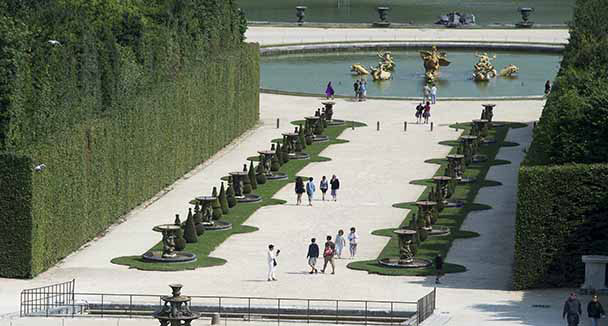
What time are the fountain shows?
Every Saturdays and Sundays from April to October, enjoy The Musical Gardens and explore the fountains and groves with their water features.
Due to high temperatures, the water display of the fountains is changed.
- The water jets are lowered all day long
- The water display of the fountains is now rotating
All day long:
- Water display of the Mirror Pool every 10 minutes
- Water display of the Neptune Foutain every 15 minutes
- Water display of the Water Theater Grove continuously
In the morning: water display of the southern groves
From 11.00 am to 12.00 am: water display of the Great Perspective
From 11.15 am to 11.45 am: water display of the Ballroom, Bacchus and Saturn’s fountains, the Colonnade and Girandole Groves’ fountains
Afternoon: water display northern groves
From 3.30 pm to 4.30 pm: water display of the Three Fountains Grove, the Pyramid foutain, the Mermaid, Water Alley and Golden children’s fountains as well as Ceres and Flora fountains, and the Girandole groves
At 4.00 pm: water display of the Great Perspective and the Dauphin’s Grove
From 3.30 pm to 5.00 pm: water display of the Enceladus and Appolon’s baths grove
At 5:20 pm: final at Neptune Fountain (water display on the last minutes of the music)
Water Garden
The Water Garden appears to be an extension of the facade of the Palace. Their layout was modified several times before receiving its definitive form, in 1685. Each pool is decorated with statues of lying-down figures representing the rivers of France, accompanied by nymphs and children.

Dragon Fountain
The Dragon Fountain represents an episode from Apollonian legend: The young Apollo kills the serpent Python with an arrow. The reptile is surrounded by dolphins and Cupids with bows and arrows, riding on swans. The main fountain reaches twenty seven metres in height.

Latona's Fountain
This group of sculpted marble figures of Latona and her children is one of the most famous works of Versailles, made in 1670 by the Marsy brothers and lending its name to the fountain on which it proudly stands. Inspired by Ovid’s Metamorphoses, Latona's Fountain illustrates the transformation of the Lycian peasants into amphibians after they prevented the goddess and her children, Diana and Apollo, from quenching their thirst. The pool and parterre surrounding the fountain, designed by André Le Nôtre, were fully restored in 2015.

The Girandole Grove
The Girandole Grove, which forms a pair with the Dauphin Grove, has seen few modifications since its creation. It is decorated with terms commissioned by Nicolas Fouquet, once Superintendent of Finances to Louis XIV, for the Château of Vaux-le-Vicomte and made in Rome after models by Poussin.

Apollo's Fountain
The original pool here was extended during the reign of Louis XIV and, in 1671, decorated with the famous gilded lead sculpture of Apollo on his chariot. The work was created by Jean-Baptiste Tuby after a drawing by Charles Le Brun and is inspired by the legend of the Sun god, the king’s emblem.

Neptune Fountain
The Neptune Fountain was made between 1679 and 1681 by Le Nôtre and was originally called “Lake Below the Dragon” or “Lake of the Pines”. The design was modified slightly in 1736 by Ange-Jacques Gabriel and the sculpted decoration glorifying the god of the sea was added in 1740. The new fountain, inaugurated by Louis XV, is composed of 99 water jets.

Flora Fountain
The Flora Fountain is located at the crossroads of several groves, including the Queen's Grove. Flora is the Roman goddess of flowers, gardens and springtime, and the fountain symbolises the first season of the year. Sculpted by Jean-Baptiste Tuby, the goddess can be found at the centre of the fountain, wearing a floral crown.

Saturn Fountain
Entirely in symmetry with the Flora Fountain, the Saturn Fountain in the south of the gardens was sculpted by François Girardon and symbolises winter. Saturn sits on a throne in the centre, surrounded by cupids, on an island dotted with seashells.

Mirror Pool
Built opposite the King's Garden, the Mirror Pool was commissioned by Louis XIV in around 1702. Built over three levels, it is framed by two dragons sculpted by Jean Hardy. Five paths lead to it, giving it an even more impressive appearance when seen from above.

Ballroom
Created by André Le Nôtre between 1680 and 1683, the Ballroom (also called the Rococo Grove after the gritstone and shells which the water cascades over) once featured a marble “island” in its centre. This island was used as a stage for dancing, an art at which Louis XIV excelled.

The Colonnade Grove
The construction of the Colonnade Grove started in 1685 under the direction of Jules Hardouin-Mansart, replacing the Spring Grove built by Le Nôtre in 1679. It takes its name from the peristyle composed of 32 marble columns surrounding the group of sculpted figures of the Abduction of Proserpina by François Girardon, made between 1678 and 1699.

Water Theatre Grove
Landscape artist Louis Benech and artist Jean-Michel Othoniel have created a permanent contemporary artwork for Water Theatre Grove.
Open every day - Access only from the Neptune fountain and North Parterre side.

Bacchus Fountain
Also known as the autumn fountain, it is the equal of the three other fountains dedicated to the seasons located close to the Royal Walk. The mythological Roman figure Bacchus spread the cultivation of vines throughout the world. God of wine and intoxication, he symbolises the grape harvest and is surrounded by small satyrs - half children, half goat.

Ceres Fountain
The square Ceres fountain was laid out between 1672 and 1679 by Thomas Regnaudin from a drawing by Charles Le Brun. Ceres, the Roman goddess of harvests, is seated on a bed of corn stalks, surrounded by cornflowers and roses. Symbolising summer, the fountain forms a group with those of Bacchus, Flora and Saturn, which represent the other three seasons.

Golden Children's Pool
Situated on the edge of the Water Theatre Grove, the Golden Children’s Pool was built in 1709 by Jules Hardouin-Mansart. This small, elliptical pool is decorated with a central group of eight cherubim sculpted in lead by Jean Hardy. It was restored in 2016.






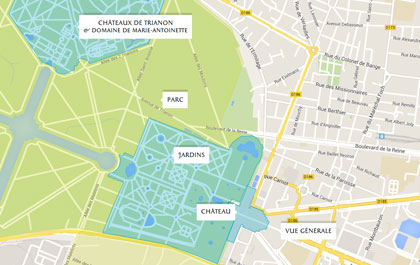
 Optimized for tablets and smartphones
Optimized for tablets and smartphones
